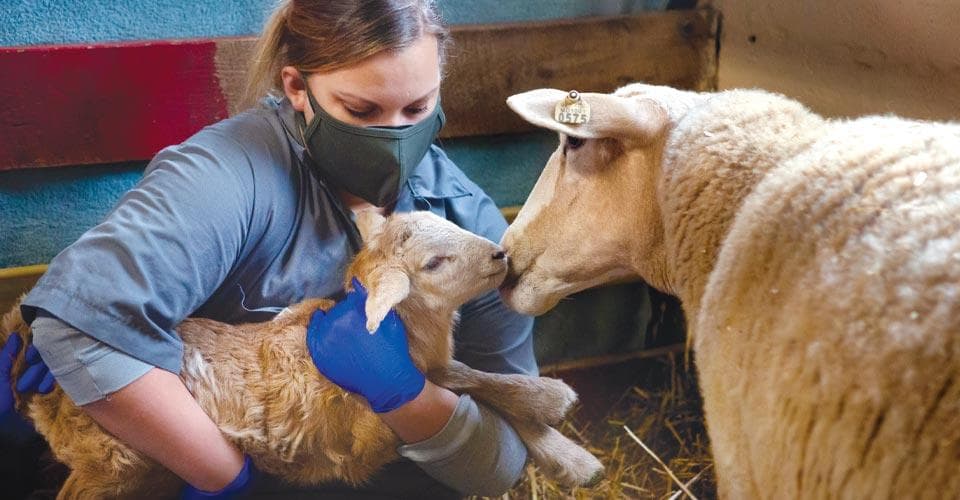Ewe-MD’s Lamb Lessons
Students in Popular Animal Science Course Help Baby Sheep Spring to Life on Campus Farm
By Annie Dankelson | Photo by Stephanie S. CordleLike any anxious relative awaiting newborn news, as soon as Avital Saletsky’s phone rang early one Saturday morning this spring, she dashed out of her Oakland Hall room. But instead of the hospital, she hightailed it to the Campus Farm, where the baby in question was utterly ovine.
Saletsky ’22 was one of 20 Terps who last semester took the hybrid “Sheep Management,” an animal science class featuring the popular “Lamb Watch” experience. Pairs of student “shepherds,” each assigned a pregnant ewe, brought information from virtual lectures to the barn, where—with COVID safety protocols in place—they helped the sheep give birth to 26 baaing bundles of joy.
“That was part of my decision of coming (to UMD), just having the Campus Farm and being able to participate in a class like that,” says Saletsky.
The course, taught by Principal Lecturer Sarah Balcom and Campus Farm Manager Crystal Caldwell, typically matches 32 Terps to 16 ewes, but those numbers were cut to 20 and 10, respectively, to make physical distancing easier amid COVID-19.
Other safety measures included wearing masks and gloves and lots of handwashing, and nightly lamb watches were switched from one four-person shift to two two-person ones. From 9-10:15 p.m. and from 10:45 p.m. to midnight (or however long was needed), student teams fed the ewes, refilled their water tins, gave them fresh bedding, cleaned and did chores, and checked for early signs of labor. The late hours helped ensure proper nutrition and care during the final stages of gestation.
Caldwell pointed a camera at suspicious sheep’s pens so she could monitor them from home and alert Terps when it was time to spring to action.
“(Students) very well may get a text that says, ‘Your ewe didn’t eat grain.’ And that’s a sign that ... she’s either feeling sick or she’s going to have a baby—or three,” she says. “So then they come and help me with the newborn processing.”
That involved drying and weighing the lambs, dipping their umbilical cords and feet in iodine, keeping them warm, making sure they were suckling and, of course, naming the newborns. (Favorite past monikers include the Hogwarts-inspired Harry, Ron and Hermione, and triplets named Snap, Crackle and Pop.)
Students then spent the rest of the semester attending sheep management labs and performing physical exams, documenting their experiences in journals.
“It’s one thing to sit in a classroom and read about how things should be done, but it’s quite another thing to have to go try it,” Balcom says. “It’s not always neat and tidy—nothing in life is.”
0 Comments
Leave a Reply
* indicates a required field

